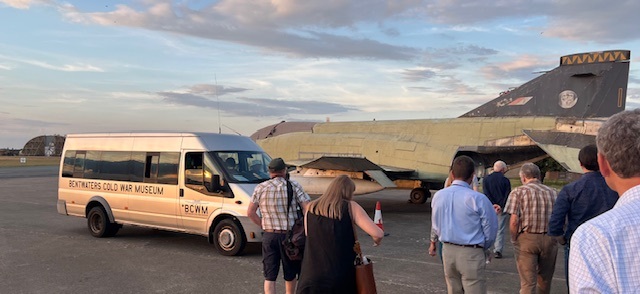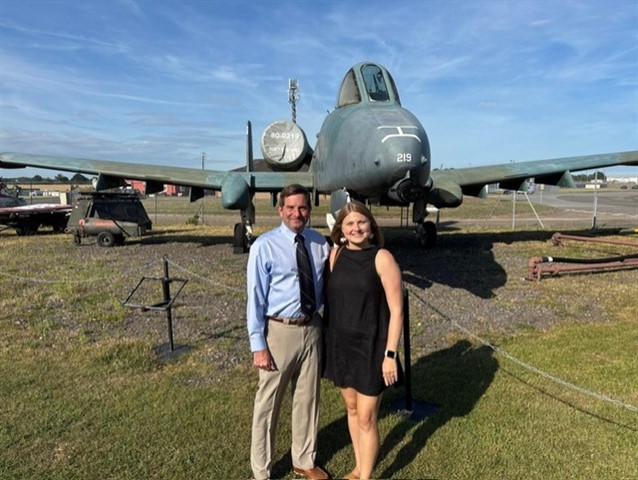On the 9th of July, 2025, a group of 32 enthusiastic members and guests embarked on a return visit to the Bentwaters Cold War Museum (BCWM) - a trip that proved just as popular and rewarding as last year’s. With registrations once again exceeding the available slots, those fortunate enough to secure a place were treated to a visit rich in history, personal stories, and hands-on experiences that brought the Cold War era vividly to life.
Nestled in the Suffolk countryside, the former RAF Bentwaters airbase played a pivotal role during the Cold War. Once a key installation for the United States Air Force (USAF) in Europe, the base was part of NATO’s first line of defence against potential Soviet aggression. Today, the museum preserves that legacy, offering visitors a rare glimpse into the military strategies, engineering marvels, and human stories that defined a tense and transformative period in world history.
A Warm Welcome and a Walk-through History
From the moment our group arrived, the sense of anticipation was palpable. A few had visited before, but the museum’s ever-evolving exhibits and the passionate dedication of its volunteers ensured that there was always something new to discover.
The day began with a guided tour through the museum’s extensive collection of Cold War artefacts, including original equipment, uniforms, documents, and aircraft. The exhibits are housed in the former hardened command post, a structure that once buzzed with activity during the height of Cold War tensions. Walking through its corridors, visitors could almost hear the echoes of operations directors, radar operators and engineers working tirelessly to maintain readiness.
Conversations with Cold War Veterans
One of the most memorable aspects of the visit was the opportunity to speak directly with two retired USAF personnel who had once served at Bentwaters. One of the veterans was retired Master Sergeant Bob Hale who gave a captivating talk about the engineering systems and operational processes that kept the base running, and he shared his personal experiences with warmth and candour. A little more about our other veteran later….
Their stories offered a human dimension to the Cold War narrative - tales of long shifts, high-stakes readiness drills, and the camaraderie that developed among those stationed far from home. For many visitors, these conversations were the highlight of the day, providing insights that no textbook or documentary could ever fully capture.
Restoring the Icons of the Sky
Another standout feature of the visit was the chance to meet the dedicated volunteers who are painstakingly restoring Cold War-era aircraft to their former glory. Two BCWM volunteers took the guests around one of the hardened hangars where there was a hive of restoration activity. Dennis Crowe (Trustee) and Geoff Grumble gave a passionate and informative talk against a backdrop of several aircraft under restoration. Among the most iconic on display was the English Electric Lightning, a supersonic interceptor that once stood as a symbol of British aerospace innovation. Other aircraft under various stages of restoration and display included the Phantom, Jaguar, Meteor, Hawker Hunter and Harrier.
Watching the restoration work up close, it was clear that this is a labour of love. Dennis and Geoff explained the challenges of sourcing original parts, the intricacies of vintage avionics, and the satisfaction of bringing these war-birds back to life. Their passion was infectious, and many visitors left with a newfound appreciation for the engineering feats of the era.

A Special Guest: Colonel Joe Skaja
The event was made even more special by the presence of retired USAF Colonel Joe Skaja, a former A-10 Thunderbolt II pilot who flew missions from Bentwaters during the 1980s. Known affectionately as the “Warthog,” the A-10 was designed for close air support and tank-busting missions - an essential asset in NATO’s defensive strategy.
Colonel Skaja shared his experiences flying the A-10 in simulated and real-world scenarios. He spoke about the unique capabilities of the aircraft, the training required to master it, and the strategic importance of Bentwaters during his time in service. His stories were not only informative but deeply personal, offering a rare glimpse into the life of a Cold War pilot, where the life expectancy in anticipated aerial combat with an advancing Soviet Union was measured in minutes.

Gratitude and Reflections
As the visit drew to a close, there was a shared sense of gratitude among the group. Gratitude to the BCWM staff and volunteers, whose tireless efforts preserve this important chapter of history. Gratitude to Colonel Skaja and Master Sergeant Bob Hale, whose presence added a unique and unforgettable dimension to the event.
For many, the visit was more than just a museum tour - it was a journey back in time, a chance to connect with the past in a meaningful and personal way. It reminded us of the sacrifices made by those who served, the technological ingenuity of the era, and the importance of remembering the lessons of history.
Looking Ahead
Given the overwhelming interest and positive feedback, it’s clear that the Bentwaters Cold War Museum has become a cherished destination for our IET members and guests. Plans are already being discussed for a return visit next year, perhaps with even more opportunities to engage with the people and stories that make this place so special.
If you haven’t yet had the chance to visit, we highly recommend adding it to your calendar. Whether you’re a history buff, an aviation enthusiast, or simply curious about the Cold War era, BCWM offers an experience that is both educational and deeply moving https://bcwm.org.uk/.
For more information on the IET’s Anglian Coastal Local Network and event programme please see https://engx.theiet.org/local-networks/ea1.
#AnglianCoastal